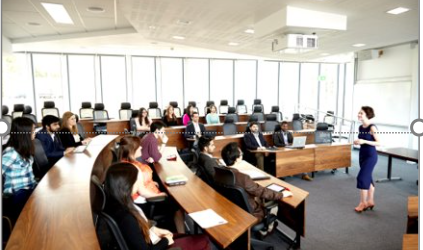An Introduction to Case-Based Learning
The Case Research Committee (CRC) oversees the Open Access Teaching Case Journal (OATCJ) and the Case Research Development Program (CRDP) at Conestoga College, School of Business. The OATCJ is published using open education practices (OEP) and is a free-to-use, free-to-publish, double-blind peer-reviewed publishing outlet.
The Case Research Development Program was developed to increase the accessibility of teaching resources, research and scholarly work and to support the free-to-publish, free-to-access, peer-reviewed, Open Access Teaching Case Journal. The purpose of the CRDP initiative is to increase opportunities for faculty to develop research skills and produce scholarly outputs, thereby contributing to our applied research mandate, while also creating quality, financially accessible, openly licensed, peer-reviewed pedagogical resources for our programs and to share with others. Conestoga Degree Program faculty have obligations to produce research and scholarly outputs for accrediting bodies such as AACSB and PEQAB and the CRDP supports this process as these accrediting bodies accept case research peer-reviewed publications for scholarly work. Please contact oatcj@conestogac.on.ca or reach out to any of the CRC members identified below for further information.
Case Research Committee Members
Jane Gravill, Fatih Yegul, Kimberlee Carter, Kevin McDermott
Jane Gravill is a professor at Conestoga College School of Business in the Accounting, Audit & IT and International Business Management degree programs. She earned her PhD from Western University, Ivey School of Business, and MBA from Queen’s University, Smith School of Business. Her research focuses on the case research methodology in the areas of Management Information Systems, Project Management and Sustainable Business Management with over 20 research cases published in leading peer-reviewed case journals.

Fatih Yegul is a professor at Conestoga College School of Business and teaches in the International Business Management degree program. He has two decades of industry experience. His background is in industrial engineering, and he holds a PhD from the University of Waterloo. His expertise and research areas are operations management and supply chain management, including a number of case research publications in these fields.

Kimberlee Carter is the open educational resource consultant at Conestoga College Institute of Technology and Advanced Learning. She holds an MA in leadership from the Gordon S. Lang School of Business, University of Guelph, and a BEd. in adult education from Brock University. Kimberlee spent 15 years as a professor preparing learners for work in the health care administration field. She has published multiple collaborative open educational resources related to health care administration as well as an open access case research publication on the topics of OER and project management.

Kevin McDermott is a researcher, post-secondary instructor, and e-learning specialist. Kevin’s scholarly interests include writing and reviewing pedagogical case studies for peer-reviewed publications. Empirical research involves automated data extraction and analytics techniques, examining social entrepreneurial resource mobilization, and motivation for the piracy of intellectual property. Kevin has instructed courses in business and technology, leadership, HR, entrepreneurship, business strategy, sustainability, among other topics at several post-secondary institutions to undergraduate and post-graduate students.

What is a widely recognized definition of case-based learning? Do cases have to be “real” or have actually occurred?
Cases must be based on factual real-life occurrences that involve actual organizations and people. Decision-makers within organizations can be invited to the classroom to discuss the case situation with students or to observe and respond to student presentations regarding their recommendations for solving the case problem. This interaction between faculty, students, and the decision-maker(s) from the organization upon which the case is based provides an engaging, enriching, and relevant applied learning experience.
Case-based learning is defined as a discussion-based learning methodology that engages students in the learning process, through the use of cases, to learn by doing and by teaching others (Leenders et al., 2001). Ideally, the use of a number of cases in a course or program can improve students’ decision-making, problem-solving, and communication skills through the repetitive opportunity to identify, analyze, and recommend solutions for a number of problems in a variety of real-world settings. This applied learning approach based upon solving problems presented in case settings within in a particular discipline can also prepare students for work in this field.
The open ended, Socratic, inquiry-based learning approach where students are challenged with solving the case problem is effective in increasing student engagement, retention and depth-of-learning.
How big are case studies? What is the variation in how long they take to deliver in class?
Cases can be any length; however, shorter cases are recommended with a guideline of 4-8 pages plus exhibits. As cases are developed to assist in teaching learning outcomes in the classroom, cases can be designed for use over several lessons. Some courses have a running case situation that is threaded throughout the course to highlight a variety of perspectives surrounding a particular case situation the extended case can address a number of learning outcomes throughout the course.
What are the key benefits and challenges of using case-based learning in post-secondary classrooms?
Case-based learning improves student engagement, satisfaction, learning retention and depth of learning and understanding of relevant, real-world problems in the discipline they are studying. Case-based assessments also provide a unique opportunity for evaluation as students are asked to apply the particular course concepts to the case situation to provide several alternatives and a recommended solution with a high-level implementation plan for the organization.
Though the case-based assessment approach requires more time and resources, it also provides an opportunity to require students to present information that is novel and more ‘AI proof’ than other traditional assessments. The challenges with case-based learning involve the availability of cost-effective case-based resources for use in the classroom and co-ordination with other instructors in the program to ensure complementary cases are used in the classroom for optimum student learning experience overall.
Where can faculty find examples of existing case studies that they can use in their classes?
The Open Access Teaching Case Journal (OATCJ) provides excellent examples of existing case studies with associated Instructors Manuals that faculty can use in their classes.
If faculty write their own cases for use in their classroom, and share with others, or select cases that are well-aligned with the learning outcomes in their courses, this tailored learning experience for students within the program can be significantly enhanced.
The Case Research Development Program offers faculty a series of workshops, presentations, internal case round table events to share ideas, and other activities to assist in improving faculty case research and writing skills. Please contact oatcj@conestogac.on.ca or reach out to any of the CRC members identified for further information. There are also some useful resources on writing, teaching and learning with cases available in the Conestoga Library. (I.e., Andrews, 2021; Naumes & Naumes, 2012). Writing cases for use in the classroom also includes the development of an effective Instructors Manual to identify the learning outcomes, theories and frameworks that are intended to be applied to the case story. The CRDP assists case writers in the process of developing effective Instructors Manuals. Free resources for writing Instructors Manuals are also available under the Case Research Journal tab of the North American Case Research Association (NACRA) website such as the Writing Outstanding Instructors Manuals and Writing Effective Learning Objectives (i.e., Brown & Ettington, 2022; Naumes 2013).
What are some things to consider when evaluating student case analysis? What advice do you have for using your provided rubric, “General Case Analysis Rubric”?
As developing case analysis skills takes practice it is important to introduce students to the case analysis method early in the course and provide opportunity for them to apply the methodology on less complex cases at first, with feedback provided on early attempts. Initially faculty can assist students in identifying the primary problems in the case, possible alternatives and developing relevant support for recommended solutions.
As students’ case analysis skills further develop, they will be able to conduct the case analysis assignment independently and incorporate increasingly complex linkages to course concepts and support for recommended solutions accompanied with realistic implementation plans.
How would you like faculty to credit you if they do decide to use this rubric as is or alter it to fit their own specific case studies?
Faculty are welcome to adapt and revise the General Case Analysis Rubric with attribution and share back the adaptation with the same license. The rubric was created using Open Education Practices (OEP) and is intended to be shared and tailored to meet individual faculty needs. The rubric has a CC-BY-NC-SA license.
[DOWNLOAD – General Case Analysis Rubric]
Where do you recommend faculty go for more information about case-based learning?
The Open Access Teaching Case Journal (OATCJ) publishes descriptive/evaluative or decision-based teaching case studies in all disciplines. Cases must be based on factual real-life occurrences that involve actual organizations and people (OATCJ does not accept fictional cases). Authors may choose to disguise the names (organizations or people) in the case. Previously published cases or articles (except those in proceedings or workshop presentations) are not eligible for consideration. There is no specific page limit expectation for the case submission, though shorter cases are preferred. The target audience for published case studies is students.
Cases are licensed CC-BY-NC-ND and are free-to-access and free-to-publish. The costs involved with editing and publishing are covered by the host institution, Conestoga College. OATCJ is aligned with the United Nation’s Principles of Responsible Management Education by offering a multi-disciplinary repository of quality, real-world teaching cases for students and instructors that are free and accessible to all. OATCJ provides a rigorous and developmentally supportive peer-review process for case authors without the expectation of financial remuneration and has a robust reviewer community from a broad spectrum of disciplines. Visit the OATCJ website to learn more.
All submissions are double-blind peer-reviewed by the OATCJ case research reviewers. Wherever possible, reviewers with subject matter expertise related to disciplines associated with submitted cases will be assigned. See the how to contribute as a reviewer section for information about becoming an OATCJ reviewer.
An instructor’s manual (teaching notes) should be included with each case submission. See the case study and teaching note guidelines for more information about the required format for case teaching notes. All teaching notes will be made available to instructors on a vetted basis.
The OATCJ is currently accepting case submissions. To submit a case, please see the OATCJ Call for Papers and case submission guidelines.
Contact OATCJ editors via email at oatcj@conestogac.on.ca.
References
Andrews, S., 2021, The case study companion: teaching, learning and writing business case studies. Routledge. https://www-taylorfrancis-com.conestoga.idm.oclc.org/books/mono/10.4324/9780367854492/case-study-companion-scott-andrews
Brown, L. and Ettington, D., 2022, Writing an Outstanding Instructor’s Manual: Note from the Editor, Case Research Journal,32(3),153-159. https://nacra.net/wp-content/uploads/2022/04/HA_WritingOutstandingIM.pdf
Leenders, M., Mauffette-Leenders, L. , Erskine, J., 2001, Learning with cases, 4th Ed., Ivey Publishing.
Naumes, M., 2013, Writing Effective Learning Objectives, Case Research Journal, 33(1), 165-171. Also available on North American Case Research Association website https://nacra.net/wp-content/uploads/2022/04/HA_WritingEffectiveLearningObjectives.pdf
Naumes, W. and Naumes, M., 2012, The Art and Craft of Case Writing: 3rd ed. Routledge. http://ra.ocls.ca/ra/login.aspx?inst=conestoga&url=https://search-ebscohost-com.conestoga.idm.oclc.org/login.aspx?direct=true&db=cat00912a&AN=cclc.945366&site=eds-live&scope=site
Power, R. 2023, Outcomes and Objectives: Untangling Outcomes, Goals, and Objectives, Everyday Instructional Design 11(6) https://pressbooks.pub/everydayid/chapter/outcomes-and-objectives/



